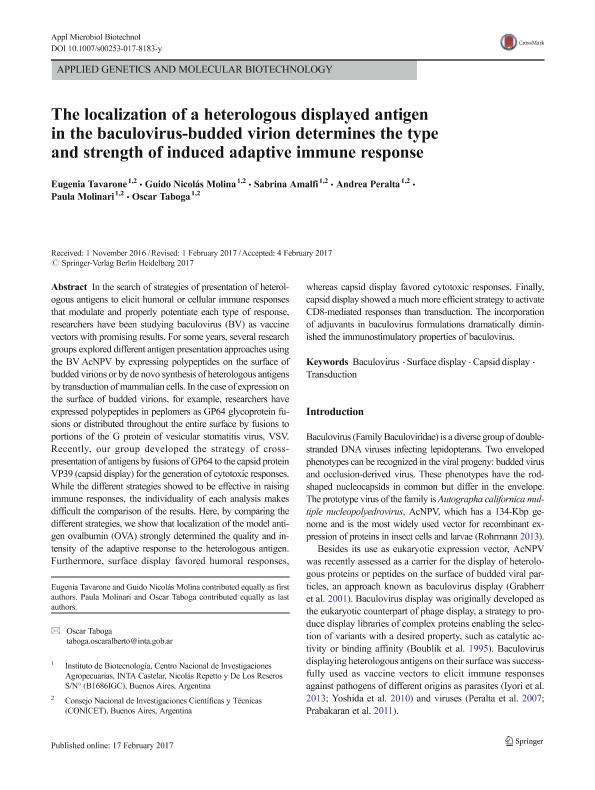Mostrar el registro sencillo del ítem
dc.contributor.author
Tavarone, Maria Eugenia

dc.contributor.author
Molina, Guido Nicolás

dc.contributor.author
Amalfi, Sabrina

dc.contributor.author
Peralta, Andrea Verónica

dc.contributor.author
Molinari, Maria Paula

dc.contributor.author
Taboga, Oscar Alberto

dc.date.available
2019-03-29T20:11:59Z
dc.date.issued
2017-05
dc.identifier.citation
Tavarone, Maria Eugenia; Molina, Guido Nicolás; Amalfi, Sabrina; Peralta, Andrea Verónica; Molinari, Maria Paula; et al.; The localization of a heterologous displayed antigen in the baculovirus-budded virion determines the type and strength of induced adaptive immune response; Springer; Applied Microbiology and Biotechnology; 101; 10; 5-2017; 4175-4184
dc.identifier.issn
0175-7598
dc.identifier.uri
http://hdl.handle.net/11336/72873
dc.description.abstract
In the search of strategies of presentation of heterologous antigens to elicit humoral or cellular immune responses that modulate and properly potentiate each type of response, researchers have been studying baculovirus (BV) as vaccine vectors with promising results. For some years, several research groups explored different antigen presentation approaches using the BV AcNPV by expressing polypeptides on the surface of budded virions or by de novo synthesis of heterologous antigens by transduction of mammalian cells. In the case of expression on the surface of budded virions, for example, researchers have expressed polypeptides in peplomers as GP64 glycoprotein fusions or distributed throughout the entire surface by fusions to portions of the G protein of vesicular stomatitis virus, VSV. Recently, our group developed the strategy of cross-presentation of antigens by fusions of GP64 to the capsid protein VP39 (capsid display) for the generation of cytotoxic responses. While the different strategies showed to be effective in raising immune responses, the individuality of each analysis makes difficult the comparison of the results. Here, by comparing the different strategies, we show that localization of the model antigen ovalbumin (OVA) strongly determined the quality and intensity of the adaptive response to the heterologous antigen. Furthermore, surface display favored humoral responses, whereas capsid display favored cytotoxic responses. Finally, capsid display showed a much more efficient strategy to activate CD8-mediated responses than transduction. The incorporation of adjuvants in baculovirus formulations dramatically diminished the immunostimulatory properties of baculovirus.
dc.format
application/pdf
dc.language.iso
eng
dc.publisher
Springer

dc.rights
info:eu-repo/semantics/openAccess
dc.rights.uri
https://creativecommons.org/licenses/by-nc-sa/2.5/ar/
dc.subject
Baculovirus
dc.subject
Capsid Display
dc.subject
Surface Display
dc.subject
Transduction
dc.subject.classification
Biología Celular, Microbiología

dc.subject.classification
Ciencias Biológicas

dc.subject.classification
CIENCIAS NATURALES Y EXACTAS

dc.title
The localization of a heterologous displayed antigen in the baculovirus-budded virion determines the type and strength of induced adaptive immune response
dc.type
info:eu-repo/semantics/article
dc.type
info:ar-repo/semantics/artículo
dc.type
info:eu-repo/semantics/publishedVersion
dc.date.updated
2019-03-29T12:08:25Z
dc.identifier.eissn
1432-0614
dc.journal.volume
101
dc.journal.number
10
dc.journal.pagination
4175-4184
dc.journal.pais
Alemania

dc.journal.ciudad
Berlin
dc.description.fil
Fil: Tavarone, Maria Eugenia. Instituto Nacional de Tecnología Agropecuaria. Centro de Investigación en Ciencias Veterinarias y Agronómicas. Instituto de Biotecnología; Argentina. Consejo Nacional de Investigaciones Científicas y Técnicas; Argentina
dc.description.fil
Fil: Molina, Guido Nicolás. Instituto Nacional de Tecnología Agropecuaria. Centro de Investigación en Ciencias Veterinarias y Agronómicas. Instituto de Biotecnología; Argentina. Consejo Nacional de Investigaciones Científicas y Técnicas; Argentina
dc.description.fil
Fil: Amalfi, Sabrina. Instituto Nacional de Tecnología Agropecuaria. Centro de Investigación en Ciencias Veterinarias y Agronómicas. Instituto de Biotecnología; Argentina. Consejo Nacional de Investigaciones Científicas y Técnicas; Argentina
dc.description.fil
Fil: Peralta, Andrea Verónica. Instituto Nacional de Tecnología Agropecuaria. Centro de Investigación en Ciencias Veterinarias y Agronómicas. Instituto de Biotecnología; Argentina. Consejo Nacional de Investigaciones Científicas y Técnicas; Argentina
dc.description.fil
Fil: Molinari, Maria Paula. Instituto Nacional de Tecnología Agropecuaria. Centro de Investigación en Ciencias Veterinarias y Agronómicas. Instituto de Biotecnología; Argentina. Consejo Nacional de Investigaciones Científicas y Técnicas; Argentina
dc.description.fil
Fil: Taboga, Oscar Alberto. Instituto Nacional de Tecnología Agropecuaria. Centro de Investigación en Ciencias Veterinarias y Agronómicas. Instituto de Biotecnología; Argentina. Consejo Nacional de Investigaciones Científicas y Técnicas; Argentina
dc.journal.title
Applied Microbiology and Biotechnology

dc.relation.alternativeid
info:eu-repo/semantics/altIdentifier/doi/http://dx.doi.org/10.1007/s00253-017-8183-y
dc.relation.alternativeid
info:eu-repo/semantics/altIdentifier/url/https://link.springer.com/article/10.1007%2Fs00253-017-8183-y
Archivos asociados
